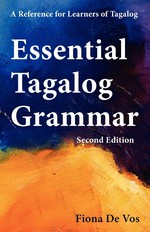Tagalog Ayaw, Gusto, Kaya, Kailangan + Basic Form
The doer is expressed as a Ng phrase (p. 59).
If the word preceding the basic form ends in a vowel or /n/, -ng may be added to it. See also: Na/-ng (p. 28)
|
Gustong kumain ni Pedro. Gusto ni Pedrong kumain. Gusto ni Pedro kumain. |
Pedro wants to eat. |
|
Kayang magluto’ ni Pedro. Kaya ni Pedrong magluto’. Kaya ni Pedro magluto’. |
Pedro can cook. |
The doer is expressed as a Ng phrase, even when the basic form is a doer-POD verb.
|
Gustong kumain ni Pedro ng mangga. (doer-POD) |
Pedro wants to eat a mango / some mangoes. |
|
Gustong kainin ni Pedro ang mangga. (object-POD) |
Pedro wants to eat the mango. |
|
Gustong sulatan ni Pedro ang teacher. (direction-POD) |
Pedro wants to write the teacher. |
See also: Roles of the POD (p. 89)
Please respect copyright. Learn more
Contents | Detailed Contents | Up ▲
See notes on Terminology and Pronunciation Marks
